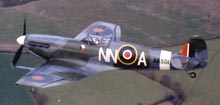| 1936 | 1938 |
 " Lysander "
" Lysander "
Probably the most famous of the Westland fixed wing aircraft...
|
 " Whirlwind "
" Whirlwind "
With the approach of war the Air Ministry identified a need for
a long-range twin engined fighter...
|
| 1940 |
Curtiss P-36 Mohawk, P-40 Tomahawk & Kittyhawk
Early in
the war Westland undertook the modification of all Mohawk, Tomahawk
and Kittyhawk fighter provided to Britain from the USA under
the Lease-lend programme, responsible for adapting the aircraft
to RAF standard.
|
|
Westland Built Spitfires And Seafires
Early
in the war disaster struck the aircraft manufacturing war effort
when the main Spitfire factory at Southampton
was totally destroyed by bombing. Westland was already working
as a sub-contractor for the Spitfire and was quickly brought
on line as a full production unit, with its own group of small
'Shadow factories' in the local area (Somerton, South Petherton,
Chard etc). The first Westland built spitfire flew in July 1941,
and production continued as part of the company's main wartime
activity.
 Westland subsequently became the main contractor for the
modification of the Spitfire for use at sea, taking design
responsibility for wing fold and arrester gear. Spitfire/Seafire
production at Yeovil was as follows:
Westland subsequently became the main contractor for the
modification of the Spitfire for use at sea, taking design
responsibility for wing fold and arrester gear. Spitfire/Seafire
production at Yeovil was as follows:
Spitfire
Mk la, Vb & Vc: 685 aircraft.
Seafire MK llc, lll, XV & XVll: 2,115 aircraft.
|
|
Westland Built Fairey Barracuda
It was originally intended that Westland should build Barracudas
in quantity, but as events transpired Spitfire and Seafire production
took priority and only 18 aircraft were completed.
|
| 1942 | 1946 |
 " Welkin "
" Welkin "
As the war progressed, attacks from high altitude bombers became
a major problem.
|
 " Wyvern TF MK 1 "
" Wyvern TF MK 1 "
The requirement for the Wyvern was placed in 1944...
|
| 1946 |
 " Wyvern TF MK 2, T MK 3 & S MK 4 "
" Wyvern TF MK 2, T MK 3 & S MK 4 "
In view of the problems with the Eagle engine...
|
|
|
The Move To Helicopters
The end of the war meant that the large aircraft
industry would have to adapt to peacetime needs. The board
of Westland Aircraft decided that the future might lie
with a totally different form of flying machine, the helicopter.
The first practical helicopters had appeared
towards the end of the war in Germany and USA, one of
the most successful American designers being Sikorsky.
In 1946 Westland negotiated a long-term agreement to build
Sikorsky designs under licence, but they also made the
bold policy decision to specialise in helicopter designs
for the future.
Work started with the Sikorsky S-51, which was
subjected to some re-design to become the Dragonfly, flying
for the first time in 1948, entering service with the
Royal Navy and RAF by 1953. Success with the Dragonfly
was repeated with other Sikorsky designs, and the firm
rapidly evolved to become a helicopter manufacturer in
its own right.
The introduction of helicopters into the Royal
Navy was to transform Naval Aviation. The use of helicopters
equipped with dipping sonar superseded fixed wing aircraft
in the anti-submarine role while helicopters brought a
whole new dimension to search and rescue.
It must not be assumed that Westland simply built
off the shelf designs under licence. In all cases the
Westland versions were subject to re-design and incorporated
many improvements.
|
| 1948 | 1952 |
 " WS-51 Dragonfly "
" WS-51 Dragonfly "
Westland built version of the Sikorsky S-51...
|
 " WS-55 Whirlwind "
" WS-55 Whirlwind "
After the Dragonflies had entered service, Westland announced
the agreement between Sikorsky...
|
| 1955 | 1957 |
 " Widgeon "
" Widgeon "
This represented Westland's first excursion into helicopter design...
|
 " WS-58 Wessex MK 1 "
" WS-58 Wessex MK 1 "
The adoption of the Sikorsky S-58 and its complete re-design, served
to strengthen the Westland design team....
|
| 1958 |
 " Westminster "
" Westminster "
The Westminster extended the Westland design organisation even further...
|
 " WS-55 Whirlwind Series 3, HAR 9 & HAR 10 "
" WS-55 Whirlwind Series 3, HAR 9 & HAR 10 "
The installation of a single Rolls-Royce Gnome turboshaft engine into the Whirlwind airframe...
|
| 1959 |
Saunders-Roe Helicopters
In August 1959, Westland acquired the helicopter and
hovercraft interests of Saunders-Roe, situated
at Eastleigh and Cowes, and which had previously taken
over the Cierva Autogyro Company in 1951.
At the time of the Westland takeover, two
helicopter projects were in progress, namely the Skeeter
and the P-531, which was subsequently developed to become
the Scout and Wasp.
|
|
 " Skeeter "
" Skeeter "
With the acquisition of Saunders-Roe Westland became responsible
for the Skeeter...
|
 " Saunders-Roe P. 531-1 "
" Saunders-Roe P. 531-1 "
Saunders-Roe were fully engaged upon the development of the P-531
project at the time of the Westland take over.
|
| 1960 |
Rationalisation Of The British Aircraft Industry 1960
In 1960 the British aircraft industry underwent a
major re-organisation. There were at the time over twenty
aircraft manufacturers, all of which were competing for
a few orders. The government of the time made it clear
that it could no longer support this situation.
The result was a period of re-organisation where
many of the companies combined to form only two major
aircraft manufacturing groups. Because of its success
in the helicopter business, Westland were well placed
to take the lead for rotary winged aircraft, there followed
a period when Westland acquired Bristol Helicopters, Fairey
Aviation and Saunders-Roe to become Westland Helicopters,
Britain's sole helicopter company with full order books
for Wessex, Scout and Wasp.
|


